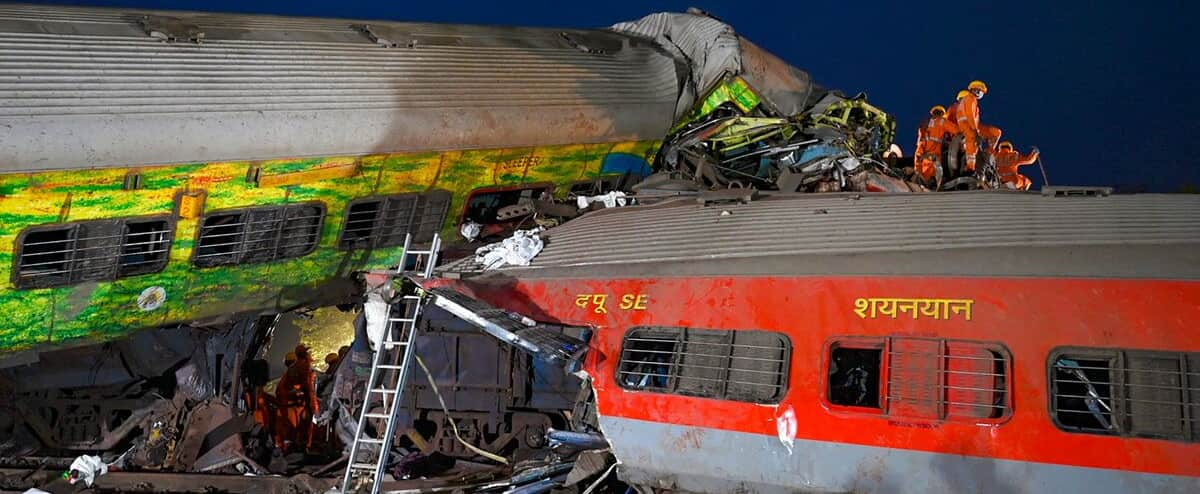India’s worst rail crash in over 20 years happened right outside his home in Balasore. It was as if “the sky was falling on us or the earth was cracking,” says Hiranmay Rath.
• Read also: At least 288 dead and more than 850 injured in train disaster in India
The sequel looks like an unimaginable nightmare, made up of corpses, body parts and suffering.
The student, who was scrolling through Facebook posts, put down his phone and rushed outside. There he saw the overturned wagons and the bodies.
“I was scared, I heard shrill screams, which became even louder in a few seconds,” Hiranmay Rath told AFP.
His picturesque yellow house, located near the railway line, is surrounded by coconut and papaya trees. Less than twenty meters away, there are now the gutted carcasses of the trains.
At least 228 people died when, according to local media citing railway officials, a signaling error sent the Coromandal Express, linking Kolkata to Chennai, on the wrong track. It then rammed into a stationary freight train, which in turn led to the derailment of an express train that was operating between Bengaluru and Kolkata.
The student, and others, rushed to help the victims. Within hours, the student says he saw more “death and distress” than he could have imagined.
“Walk on corpses”
“There were severed arms, legs, and even some heads that were partially severed. The unlucky ones died in pain, too much pain,” he said.
With four or five neighbors, he managed to extract a woman dressed in a sari from the wrecked wagon closest to her house.
“A policeman told us to carry her, because she had a net of life left, to a place from where the survivors could be taken in for treatment.”
“She was just asking for water, in a very low voice, as we carried her in a long piece of cloth.” “But when we put her on the side of the road, she didn’t move and died before our eyes.”
In all, the small group managed to extract 25 people from the wreckage. Some had trouble breathing, others were already dead.
“There are images that I will never forget,” he says. “Imagine looking at – or extracting – someone’s crushed body, severed arm or leg.”
Ordinarily, his grandfather Bhagwat Prasad Rath, 80, enjoyed sitting by the train tracks in the evenings, enjoying the fresh air and greenery.
He was not injured in the accident, but had to cross the bloody tracks to get home.
“I had no choice but to walk over corpses,” he says. “I took off my flip flops and walked over them praying to God to forgive me.”
“Horrible and shrill” noise
When day broke at the scene of the tragedy, located in the state of Odisha, it revealed the extent of the destruction.
The red and green wagons were stacked on top of each other or thrown away from the tracks, along which rows of corpses had been laid.
A wagon literally overturned, crushing the passengers in shock.
On the floor, among the metal debris and what used to be the seats, there is a suitcase, a child’s shoe, piles of clothes.
Mechanical cranes lift the carcasses, emergency personnel cut through metal in an attempt to reach the still trapped victims, rows of workers from different agencies work along the lane, and emergency vehicles block the roads of access.
Anubhav Das, 27, a researcher, was in the last carriage of the Coromandal Express. He heard a “horrible and shrill” noise before the train came to a sudden stop.
He, and his 30 fellow travelers were unharmed and rushed off the train. Outside there was chaos and “awful noises”. “I saw bodies without heads, and others without limbs, bloody bodies,” he said.
He tried to grab what he could find to make bandages. “It was almost like war. I counted 250 bodies and then I stopped counting”. “I saw a man bleeding, his arm severed, and his injured son desperately trying to help him. I saw a family of five, all dead.
From his house in Cuttack where his father drove him after the accident, he assures AFP: “It is an absolute miracle to have survived”.



